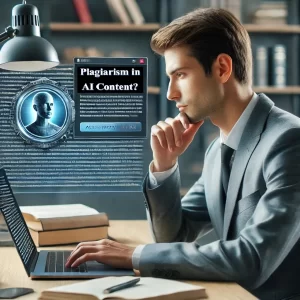Can AI content pass a plagiarism check? What you need to know

With the rise of AI-powered writing tools like ChatGPT, Jasper, and Copy.ai, many content creators, students, and businesses rely on AI-generated text for their writing needs. However, one critical question remains: Can AI content pass a plagiarism check?
While AI-generated content is not directly copied from existing sources, plagiarism detection tools like Turnitin, Grammarly, and Drillbit, analyze text for similarities, raising concerns about whether AI content is truly original. This article explores how plagiarism checkers handle AI-written text, the risks of AI-generated content, and the best practices to ensure originality.
How plagiarism checkers analyze AI content
Plagiarism checkers do not just compare text against published sources; they use advanced algorithms to detect text similarities, structure patterns, and repeated phrases. Here’s how they analyze AI-generated content:
Database comparison
- Plagiarism checkers compare submitted text against academic papers, websites, books, and other sources.
- AI-generated content may contain similar sentence structures or commonly used phrases found in existing materials.
Text pattern recognition
- AI tools often generate content using predictive text models, which may result in sentences that resemble existing ones.
- Some AI outputs are not directly copied but follow similar phrasing patterns, making them detectable.
AI-content detection tools
- Some plagiarism checkers, including Turnitin’s AI detector, are now designed to flag AI-generated content.
- These tools identify patterns, lack of human variation, and robotic phrasing to determine AI involvement.
💡 Solution: To avoid detection, AI-generated content should be thoroughly edited, rewritten, and combined with original human input.
Why AI content can fail a plagiarism check
Even though AI-generated text is not intentionally plagiarized, it may still get flagged due to various reasons.
Commonly used phrases and data repetition
- AI tools generate content by predicting the most statistically likely words and structures, often leading to common phrases found in many published works.
- Plagiarism checkers may detect high similarity scores if many sentences match existing sources.
Self-plagiarism risk
- If multiple users generate content using the same AI model, there is a chance of overlapping text output, leading to self-plagiarism.
- AI-generated text is not uniquely created for each user, so some phrasing may appear repeatedly across different pieces of content.
Lack of citations for factual information
- AI-generated content often includes facts and statistics without citing sources.
- This can lead to unintentional plagiarism when factual claims are not properly referenced.
💡 Solution: Always add citations for factual content and rephrase AI-generated text to ensure uniqueness.
Can AI-generated content be 100% original?
AI content can be original if properly modified and personalized. Here’s how to make AI-generated text unique:
Paraphrase AI-generated content
- Instead of using AI-generated text as-is, rewrite sections in your own words.
- Ensure sentence structure and phrasing are significantly different from the AI’s output.
Add human insights and analysis
- AI lacks personal experiences and deep insights.
- Adding personal opinions, original research, or unique case studies ensures your content is not purely AI-generated.
Use AI as a writing assistant, not a replacement
- AI works best for idea generation, structuring content, and grammar correction.
- Always refine AI-generated text with a human touch to improve clarity and originality.
💡 Solution: AI-generated content should always be reviewed and modified to maintain originality and authenticity.
How AI-detection tools are evolving
As AI-generated content becomes more common, plagiarism detection tools are also advancing to identify AI writing patterns. Some new developments include:
Turnitin’s AI detection feature
- Turnitin has integrated AI-content detection into its plagiarism checker.
- It highlights AI-generated text portions and provides a confidence score on AI involvement.
Natural Language Processing (NLP) enhancements
- Advanced plagiarism checkers use NLP models to detect unnatural phrasing.
- If content lacks human-like variation, it may get flagged as AI-generated.
AI-generated content watermarking
- Some AI developers are working on embedding invisible watermarks in AI-generated text to track usage.
- This may help identify AI-written content in the future.
💡 Solution: Always blend AI-generated content with human-written text to ensure it passes AI-detection tools.
Best practices to ensure AI-generated content passes a plagiarism check
To ensure AI content is original and undetectable, follow these best practices:
Rewrite and personalize content
- Avoid using AI-generated text word-for-word.
- Modify sentence structures, add examples, and personalize text.
Check AI content with plagiarism detection tools
- Run AI-generated text through plagiarism checkers like Drillbit, Turnitin, or Grammarly.
- Identify and fix flagged similarities before submission.
Use AI responsibly and ethically
- AI should be used as a support tool, not as a full content creator.
- Balance AI assistance with human creativity and research.
💡 Solution: Always edit, proofread, and verify AI-generated text before finalizing it for academic, business, or content marketing purposes.
Conclusion: can AI content truly pass a plagiarism check?
AI-generated content can pass plagiarism detection if properly edited and personalized. However, if used without modifications, AI-written text may get flagged due to:
- Similarity with existing sources
- Common phrasing patterns
- Lack of citations and factual references
- AI-detection tools improving over time
Key takeaways:
- AI content should be reworded and combined with human insights for originality.
- Plagiarism checkers are evolving to detect AI-generated writing.
- Proper citation and personal input ensure AI-assisted content remains authentic and plagiarism-free.
💡 Final tip: Always run AI-generated content through a plagiarism checker and refine it to ensure originality and credibility! 🚀
